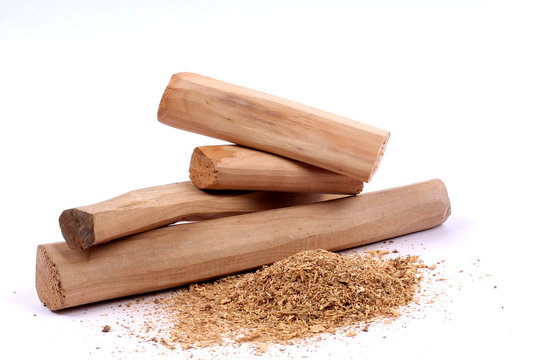Have you ever seen a sandalwood tree? If you have not seen, you must have heard at some time that there is a tree named Chandan, which is very fragrant. Many people use sandalwood to decorate their homes. Items of worship such as incense sticks, incense sticks etc. are also made with chandan sticks. Sandalwood is expensive, so it is also smuggled.
Actually, people know only this much about the sandalwood tree. Most people do not know that sandalwood is also a very beneficial herb, and sandalwood has been used for many years for healing. Let us know in which disease you can benefit from the use of sandalwood.
What is Chandan
Sandalwood is a herb. It gives people joy due to being fragrant and cool, hence it is called sandalwood. Sandalwood trees are green and 6 to 9 meters high. Its branches are bent. The bark of the sandalwood tree is red (rakta chandan), or brown, or brown-black. Sandalwood leaves are elliptical, soft, and the front part of the leaf is pointed. Sandalwood flowers are brownish-purple, or purple in color, which are odorless. Its fruits are spherical, fleshy, which become ripe, or purple when ripe.
Sandalwood trees usually grow only after 20 years. The inner part of the tree is light yellow in color, and fragrant. The bark of old trees is cracked. The sandalwood tree turns into a fragrant fragrance after 40-60 years of age. The flowers in the sandalwood tree are from June to September, and the fruits from November to February. In such a situation sandalwood becomes fully usable. Some features of the sandalwood tree are:
Sandalwood is best produced in Orissa. Sandalwood produced in India-Greece (Yavan country) region is slightly lower in quality. Sandalwood occurring in places like western Uttar Pradesh etc. is said to be of the lowest quality. Odisha sandalwood is best in terms of smell. According to Ayurveda, sandalwood trees are not the only kind. There are different types of sandalwood trees in the country and abroad, which are: -
1. Best symptoms of sandalwood The sandalwood which is of very good quality is white in appearance, but when sliced, it is red in color. On grinding it, a yellow colored substance comes out of it. Its aroma is slightly pungent. 2.Wett Chandan This sandalwood is very cold. With this, diseases like burning, fever, vomiting, phlegm etc. can be cured.
3. Pitchand This sandalwood is also pungent in aroma, and cool. It is beneficial in leprosy, phlegm, fever, burning sensation. Used in shingles, gout, toxins, blood disorders etc.
Chandan Benefits and Uses
By now you have known what is sandalwood, how it is made, and how many names of sandalwood are there. Now let us know how sandalwood is used medicinally, what should be its quantity, and what are its methods?
You can take advantage of sandalwood in this way: -
Use of sandalwood for the problem of excessive thirst
Some people are always thirsty. Actually this is a problem. In such a way, mix 2-4 grams of chandan powder in 20-40 ml coconut water. Drinking this causes thirst.
Benefit of Chandan in Sneezing Problem in Hindi Women or men sometimes have sneeze problems. In this case, grind sandalwood and coriander leaves. Smelling it stops sneezing.
Chandan Benefits for Hiccup in Hindi) If you are troubled by hiccups, take lentils, palandu, or carnivores, and white sandalwood. Grind it with cow's milk. Add 1-2 drops to the nose. The hiccup stops.
uses of Chandan in Reducing Inflammation Grind the sandal wood in water, and grind the bark of the stem and apply it on the body. It cures swelling.Chandan Benefits in Itching Treatment in Hindi You can cure itching disease by using sandalwood. Grind sandalwood with water and apply it on the skin. It cures itching. Mix lemon juice and camphor in sandalwood oil. Itching is cured by applying it. Uses of Chandan in Treating Acne Acne is a common problem. Whether women or men, all suffer from acne. For this you rub sandalwood. Apply it in the mouth. It cures pimples and facial freckles.
Benefits of Chandan to Treat Skin disease in Skin diseases Sandal can be used in many skin disorders. Many skin disorders are cured by grinding sandal wood with water and applying it. After skin rashes, mix 2-4 grams of chandan powder in Guduchi-juice. Consuming it is beneficial. Benefits of using sandalwood in the smell of sweat.
powder on the navel, in 20-40 ml coconut water. It gives comfort.
Useful Parts of Chandan You can use sandalwood in this way: - In the humid state, chopped chandhan cures bile disease. Cut sandalwood in dry state cures gout. Chopped sandalwood in middle age, cures phlegm. Use of sandalwood oil provides chandan benefits in phlegm, burning, skin, jaundice, respiratory diseases, fever, weakness etc.
How to use sandalwood? (How to Use Chandan?) You can use sandalwood in this quantity: - Sandal powder - 3-6 grams Sandalwood oil - 5-20 drops Brew - 2-4 ml Sandalwood Girl Oil - 0.3-1 ml The root To take full advantage of sandalwood, consult a doctor before use.
Side Effects of Chandan Using proper amount of sandalwood does not have any side effects on health, but in some cases the use of sandalwood can cause the following side effects: - If someone has an allergy-like problem, sandalwood can cause a reaction in their skin. Excessive intake can cause problems such as stomach disorders, skin disorders, depression, vomiting, or uremia.
Where is sandalwood found or grown? (Where is Chandan Found or Grown?) Chandan (chandhan) is cultivated at many places. Sandalwood is cultivated in India in Karnataka, Tamil Nadu, Kerala, South Andhra Pradesh, Madhya Pradesh. Sandalwood is found in Malabar up to a height of 1200 meters, and also in Rajasthan, Uttar Pradesh and Orissa.



Comments
Post a Comment